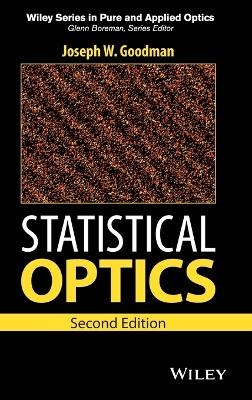
Statistical Optics
Wiley-Blackwell (Verlag)
978-1-119-00945-0 (ISBN)
This book discusses statistical methods that are useful for treating problems in modern optics, and the application of these methods to solving a variety of such problems
This book covers a variety of statistical problems in optics, including both theory and applications. The text covers the necessary background in statistics, statistical properties of light waves of various types, the theory of partial coherence and its applications, imaging with partially coherent light, atmospheric degradations of images, and noise limitations in the detection of light. New topics have been introduced in the second edition, including:
Analysis of the Vander Pol oscillator model of laser light
Coverage on coherence tomography and coherence multiplexing of fiber sensors
An expansion of the chapter on imaging with partially coherent light, including several new examples
An expanded section on speckle and its properties
New sections on the cross-spectrum and bispectrum techniques for obtaining images free from atmospheric distortions
A new section on imaging through atmospheric turbulence using coherent light
The addition of the effects of "read noise" to the discussions of limitations encountered in detecting very weak optical signals
A number of new problems and many new references have been added
Statistical Optics, Second Edition is written for researchers and engineering students interested in optics, physicists and chemists, as well as graduate level courses in a University Engineering or Physics Department.
Joseph W. Goodman is an engineer and physicist. He has held a number of positions in the field of optics, including the presidency of the Optical Society of America and the presidency of the International Commission for Optics. He chaired the Department of Electrical Engineering at Stanford University from 1988 until 1996, and served as Senior Associate Dean of Engineering from 1996 through 2000.
1 Introduction 1
1.1 Deterministic Versus Statistical Phenomena and Models 2
1.2 Statistical Phenomena in Optics 3
1.3 An Outline of the Book 5
2 Random Variables 6
2.1 Definitions of Probability and Random Variables 6
2.2 Distribution Functions and Density Functions 8
2.3 Extension to Two or More Joint Random Variables 12
2.4 Statistical Averages 14
2.5 Transformations of Random Variables 20
2.6 Sums of Real Random Variables 27
2.7 Gaussian Random Variables 32
2.8 Complex-Valued Random Variables 37
2.9 Random Phasor Sums 42
2.10 Poisson Random Variables 52
3 Random Processes 56
3.1 Definition and Description of a Random Process 56
3.2 Stationarity and Ergodicity 59
3.3 Spectral Analysis of Random Processes 64
3.4 Autocorrelation Functions and the Wiener-Khinchin Theorem 69
3.5 Cross-Correlation Functions and Cross-Spectral Densities 75
3.6 Gaussian Random Processes 78
3.7 Poisson Impulse Processes 80
3.8 Random Processes Derived from Analytic Signals 93
3.9 The Circular Complex Gaussian Random Process 101
3.10 The Karhunen-Loeve Expansion 102
4 Some First-Order Statistical Properties of Light 109
4.1 Propagation of Light 110
4.2 Thermal Light 114
4.3 Partially Polarized Thermal Light 119
4.4 Single-Mode Laser Light 130
4.5 Multimode Laser Light 143
4.6 Pseudothermal Light Produced by Passing Laser Light Through a Changing Diffuser 148
5 Temporal and Spatial Coherence of Optical Waves 152
5.1 Temporal Coherence 153
5.2 Spatial Coherence 172
5.3 Separability of Spatial and Temporal Coherence Effects 188
5.4 Propagation of Mutual Coherence 191
5.5 Special Forms of the Mutual Coherence Function 196
5.6 Diffraction of Partially Coherent Light by a Transmitting Structure 202
5.7 The Van Cittert-Zernike Theorem 208
5.8 A Generalized Van Cittert-Zernike Theorem 214
5.9 Ensemble-Average Coherence 218
6 Some Problems Involving Higher-Order Coherence 227
6.1 Statistical Properties of the Integrated Intensity of Thermal or Pseudothermal Light 228
6.2 Statistical Properties of Mutual Intensity with Finite Measurement Time 243
6.3 Classical Analysis of the Intensity Interferometer 249
7 Effects of Partial Coherence in Imaging Systems 262
7.1 Preliminaries 263
7.2 Space-Domain Calculation of Image Intensity 269
7.3 Frequency Domain Calculation of the Image Intensity Spectrum 274
7.4 The Incoherent and Coherent Limits 280
7.5 Some Examples 286
7.6 Image Formation as an Interferometric Process 293
7.7 The Speckle Effect in Imaging 308
8 Imaging Through Randomly Inhomogeneous Media 323
8.1 Effects of Thin Random Screens on Image Quality 324
8.2 Random-Phase Screens 328
8.3 The Earth's Atmosphere as a Thick Phase Screen 336
8.4 Electromagnetic Wave Propagation Through the Inhomogeneous Atmosphere 344
8.5 The Long-Exposure OTF 352
8.6 The Short-Exposure OTF 375
8.7 Stellar Speckle Interferometry 382
8.8 The Cross-Spectrum or Knox-Thompson Technique 392
8.9 The Bispectrum Technique 398
8.10 Adaptive Optics 401
8.11 Generality of the Theoretical Results 404
8.12 Imaging Laser-Illuminated Objects through a Turbulent Atmosphere 406
9 Fundamental Limits in Photoelectric Detection of Light 415
9.1 The Semiclassical Model for Photoelectric Detection 416
9.2 Effects of Random Fluctuations of the Classical Intensity 417
9.3 The Degeneracy Parameter 429
9.4 Noise Limitations of the Amplitude Interferometer at Low Light Levels 439
9.5 Noise Limitations of the Intensity Interferometer at Low Light Levels 449
9.6 Noise Limitations in Stellar Speckle Interferometry 456
Appendix A The Fourier Transform 471
A.1 Fourier Transform Definitions 471
A.2 Basic Properties of the Fourier Transform 473
A.3 Tables of Fourier Transforms 476
Appendix B Random Phasor Sums 478
Appendix C The Atmospheric Filter Functions 484
Appendix D Analysis of Stellar Speckle Interferometry 489
Appendix E Fourth-Order Moment of the Spectrum of a Detected Speckle Image 493
Bibliography 496
Index 509
| Erscheint lt. Verlag | 2.6.2015 |
|---|---|
| Reihe/Serie | Wiley Series in Pure and Applied Optics |
| Verlagsort | Hoboken |
| Sprache | englisch |
| Maße | 144 x 242 mm |
| Gewicht | 770 g |
| Themenwelt | Mathematik / Informatik ► Mathematik ► Statistik |
| Naturwissenschaften ► Physik / Astronomie ► Optik | |
| Technik ► Elektrotechnik / Energietechnik | |
| ISBN-10 | 1-119-00945-6 / 1119009456 |
| ISBN-13 | 978-1-119-00945-0 / 9781119009450 |
| Zustand | Neuware |
| Haben Sie eine Frage zum Produkt? |
aus dem Bereich


